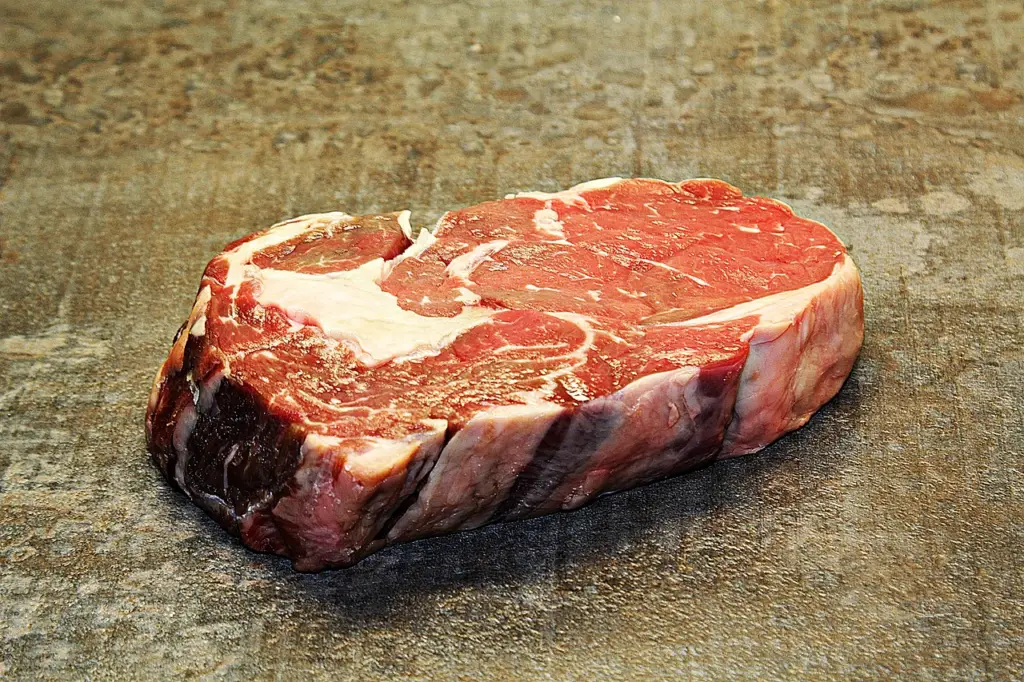Share via:
Have you ever wondered how many ribeyes in a cow? It’s a valid question, especially if you’re planning a big BBQ or just want to stock up your freezer.

So, I did some research to find out the answer. The result? Well, it’s not as simple as you might think. The number of ribeye steaks you can get from a cow depends on various factors, including the cow’s size, breed, and age.
In this grillcuisines.com guide, I’ll cover:
- Where is the ribeye steak on a cow and different cuts of beef
- How many ribeyes per cow
- Factors that affect the quantity and quality of ribeye steak
Where Is The Ribeye On A Cow?

Understanding the anatomy of a cow is essential for knowing how many ribeye steaks can be obtained from a single cow.
The cow’s body is divided into two main sections: the forequarter and the hindquarter. The forequarter consists of the neck, chuck, brisket, rib, and plate, while the hindquarter includes the loin, sirloin, round, and flank.
So Where Is The Ribeye On A Cow? The ribeye comes from the rib section of the cow, which is located between the chuck and loin. This area is where the most tender and flavorful cuts of meat are found, including the ribeye and the prime rib.
The rib section of a cow is composed of 13 pairs of ribs, extending from the spine and wrapping around the sides of the animal.
Ribeye steak is cut from the sixth to the twelfth rib. These ribs are located closer to the back of the animal, between the chuck (shoulder) and the loin (rear) sections.
The ribeye steak is highly regarded for its exceptional flavor, tenderness, and marbling. The marbling refers to the small flecks of fat dispersed throughout the meat, which enhance its juiciness and contribute to its rich, buttery taste. This marbling is what gives ribeye steak its signature texture and succulence.
The meat from the rib section, including the ribeye, is typically well-exercised, which contributes to its robust flavor.
The muscles in this area provide support for the cow’s upper body, resulting in meat that has a good amount of intramuscular fat, or marbling. This fat adds both moisture and flavor to the steak, making it a favorite among meat lovers.
Due to its tenderness and superb flavor, the ribeye steak is often considered one of the most desirable cuts of beef.
It is commonly prepared by grilling, pan-searing, or broiling to bring out its natural flavors and achieve a caramelized exterior while maintaining a juicy and tender interior.
Different Cuts Of Beef
Beef is typically divided into two main categories: primal cuts and retail cuts.
Primal cuts are large sections of beef that are separated from the animal during the butchering process. These cuts are then further divided into retail cuts.
Retail cuts are the cuts of meat that you see at the grocery store or butcher shop. Retail cuts are what most people are familiar with, and they include popular cuts like ribeye, sirloin, and filet mignon.
Primal Cuts Of Beef
There are eight primal cuts of beef: chuck, rib, loin, round, brisket, shank, short plate, and flank. Each primal cut has its unique characteristics, including flavor, tenderness, and fat content.
Related >> 7 Most Tender Steak Cuts In The Market
1- Chuck:
The chuck is the primal cut that comes from the shoulder area of the cow. It is a tough and flavorful cut that is best suited for slow-cooking methods such as braising or stewing.
The chuck contains several muscles and is often separated into smaller retail cuts like chuck roast, chuck steak, or beef short ribs.
2- Rib Primal Cut
The rib primal cut is located between the chuck and the loin. It is one of the most highly prized cuts of beef, and it includes some of the most expensive retail cuts like ribeye and prime rib. The rib primal is tender and has a rich, buttery flavor due to its high-fat content.
3- Loin Primal Cut
The loin primal cut is located along the back of the cow and is divided into two sections: the short loin and the sirloin. The short loin is home to some of the most popular cuts of beef, including filet mignon, T-bone, and porterhouse steaks.
The sirloin is less tender than the short loin but still produces flavorful retail cuts like top sirloin and sirloin steak.
4- Round Primal Cut
The round primal cut is the leanest and toughest of all the primal cuts. It comes from the rear leg of the cow and is best suited for slow-cooking methods like roasting or braising. The round is often divided into smaller retail cuts like eye of round, bottom round, and top round.
5- Brisket Primal Cut
The brisket primal cut comes from the breast area of the cow and is a tough, flavorful cut that requires slow-cooking methods like smoking or braising. It is often used to make dishes like corned beef and pastrami.
6- Shank Primal Cut
The shank primal cut is located in the lower leg of the cow and is also a tough, lean cut that requires slow cooking. It is often used to make beef stock or stews.
7- Short Plate Primal Cut
The short plate primal cut is located below the rib and is known for its rich, beefy flavor. It is often used for dishes like beef ribs and skirt steak.
8- Flank primal cut
Finally, the flank primal cut comes from the abdominal area of the cow and is a tough, lean cut that is best suited for marinating and grilling.
Knowing the different primal cuts of beef and their characteristics can help you choose the right cut for your recipe and ensure that you get the best flavor and tenderness from your beef.
How Many Ribeyes In A Cow
On average, a typical cow can yield around 12 to 14 ribeye steaks. The exact number of ribeye steaks that can be obtained from a cow depends on various factors, including the size and weight of the cow, as well as the desired thickness of the steaks.
A mature cow can weigh anywhere from 1,000 to 1,500 pounds (450 to 680 kilograms).
A standard ribeye on cow is usually around 8 to 12 ounces (225 to 340 grams) in weight. The weight of each ribeye steak, can also vary depending on the desired thickness and variations in butchering.
Here is a comparison table showing the types of steaks you can expect from a whole cow, half cow, and quarter cow:
| Type of Steak | Whole Cow | Half Cow | Quarter Cow |
|---|---|---|---|
| T-Bone | 12-14 | 6-7 | 3-4 |
| Porterhouse | 8-10 | 4-5 | 2-3 |
| Ribeye | 20-22 | 10-11 | 5-6 |
| Sirloin | 18-20 | 9-10 | 4-5 |
| Flank | 6-8 | 3-4 | 1-2 |
| Round | 12-14 | 6-7 | 3-4 |
Related >> How Many Steaks in Half a Cow?
Factors Affecting The Quality Of Ribeye Steak From A Cow
The quality of a ribeye steak from a cow can be influenced by several factors, such as:
Related >> How To Fix Tough Cooked Steak? [8 Ways To Tenderize Steak]
1- Marbling
Marbling refers to the intramuscular fat found within the ribeye steak. A higher degree of marbling is generally desirable because it contributes to the tenderness, juiciness, and flavor of a cut of beef.
2- Age
The age of the cow can affect the quality of the ribeye. Younger cows tend to produce more tender and flavorful meat compared to older cows.
3- Breed
Different cattle breeds have distinct characteristics that can impact the quality of the ribeye. Some breeds are known for their exceptional marbling and tenderness, such as Angus or Wagyu cattle.
4- Diet
The diet of the cow plays a significant role in the quality of the meat. Cattle that are raised on high-quality, nutritious feed and grazing on open pastures tend to produce superior ribeye steaks compared to those fed a lower-quality diet.
5- Animal Welfare
The overall well-being and stress levels of the cow can impact the tenderness and quality of the meat. Cattle raised in low-stress environments and provided with proper care and handling tend to yield better-quality ribeye steaks.
6- Butchering and Aging
Proper butchering techniques and appropriate aging of the meat can also affect the quality of the ribeye steak. The aging process allows the meat to develop enhanced tenderness and flavor.
It’s important to note that these factors interact with each other, and the quality of the ribeye steak is a result of their combined influence.
Professional farmers, ranchers, and butchers pay close attention to these factors to ensure the production of high-quality ribeye on cow that meet consumer expectations.
Factors Affecting Number Of Ribeye Steaks From A Cow
The quantity or number of ribeye steaks that can be obtained from a cow can be influenced by several factors, including:
1- Carcass Size
The overall size and weight of the cow’s carcass can impact the number of ribeye steaks that can be obtained. Larger cows typically produce more substantial ribeye steaks, while smaller cows may produce smaller-sized steaks.
2- Butchering Technique
The technique used during the butchering process can affect the number of ribeye steaks. Skilled butchers have the expertise to precisely cut the ribeye steaks from the rib section, and may be able to get more ribeye steaks than an unexperienced butcher.
3- Fat Trimming
Trimming excess fat from the rib section can impact the overall yield of ribeye steaks. Some fat is desirable for flavor and juiciness, but excessive fat can reduce the quantity of usable meat.
4- Ribeye Thickness
The desired thickness of ribeye steaks can vary. Thicker cuts may result in fewer total steaks, while thinner cuts can increase the quantity obtained.
5- Individual Rib Size
Each rib within the rib section may have slightly different dimensions, which can affect the size and number of ribeye steaks. Some ribs may yield larger steaks, while others may be smaller.
6- Customization Requests
If specific cuts or customizations are requested by the consumer, such as bone-in ribeye steaks or different thicknesses, it can impact the overall quantity of ribeye steaks obtained.
How does the weight of the cow correlate with the quantity of ribeye steaks?
The weight of the cow can have an impact on the quantity of ribeye steaks obtained. Generally, larger cows tend to yield a higher number of ribeye steaks due to their larger overall size. As the weight of the cow increases, the rib section also becomes larger, providing more room for ribeye steaks to be cut.
Wrap Up:
How many ribeye per cow depends on the size of the cow, butchering techniques, and individual preferences.
On average, a cow can yield around 12 to 14 ribeye steaks, but this can vary. The weight of each ribeye steak can range from about 8 to 16 ounces (227 to 454 grams), providing ample portions for a satisfying meal.
The quantity and quality of ribeye steaks can vary based on the breed, diet, and other factors that affect the animal’s overall health and growth. To get the best results when cooking a ribeye steak, it’s important to choose high-quality meat, select the right cut, and prepare it properly.
Related Articles:
The Complete Guide to Cooking a Ribeye on Traeger
How Long to Cook Steak On Pellet Grill? (At 350, 400)
I am a writer, editor, and publisher of Grillcuisines.com – an online blog dedicated to sharing grilling tips, accessories, and recipes to encourage more people to get outside and grill.
I’m off to find out the different types of grill foods, their seasons, and how to conduct outdoor cooking properly. I’ll also show you some of my grill-worthy cooking tools & accessories!


